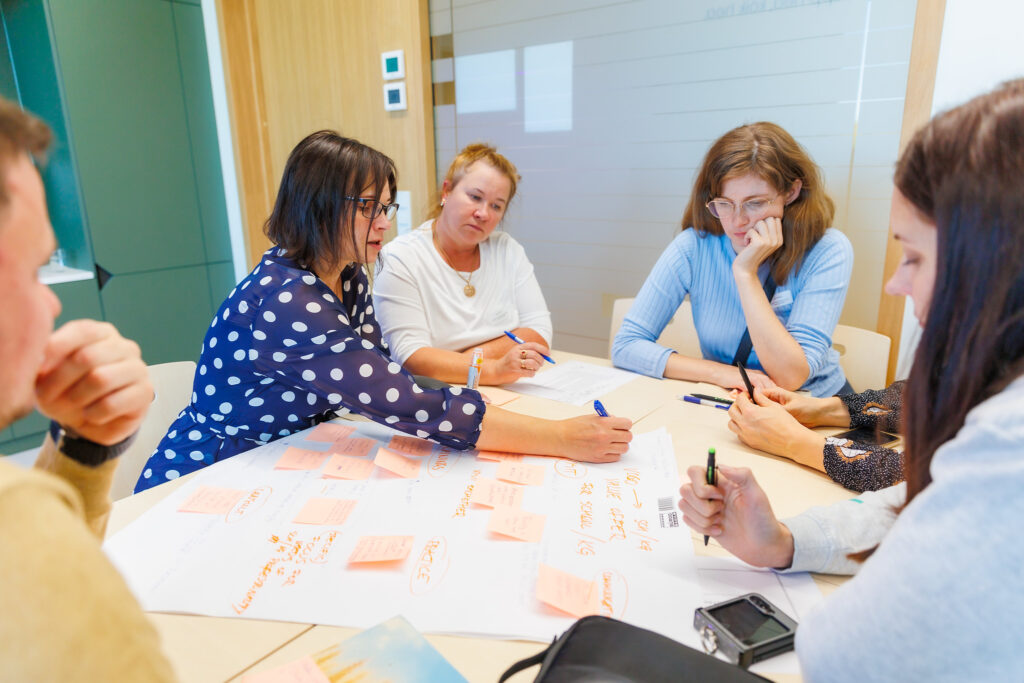By: Maris Väli-Täht
From: Tartu BT Park
Tartu BT Park, in cooperation with the Association of the Municipalities in Tartu County and the Estonian Academy of Life Sciences, have jointly created a school meals program “Making School Community Food-wise” that focuses on both improving children’s food education and reducing food waste in schools. The program was developed as part of the Interreg KISMET project (KISMET – Sustainable Food Environments & Circular Food Systems) where Tartu BT Park acts as a project partner.
The school meals program responded to growing awareness of the critical role school meals play in students’ wellbeing and aimed to support schools in developing a healthier, more collaborative and more conscious food culture. Designed as a pilot, the program ran throughout the 2024/2025 academic year in five diverse schools across Tartu County.
Around the same table: school administration, teachers, students and kitchen staff
Each participating school formed a broad, multidisciplinary team including leadership, teachers, students, parents, catering staff, local authorities, and in some cases, school nurses. The goal was to bring together everyone involved in shaping students’ food experiences and to create space for joint reflection, learning, and action.
At the start of the program, each school conducted a comprehensive self-assessment to understand its current food environment—what was working well and where challenges lay. Based on these reflections, schools set development goals and created tailored action plans, implemented with mentor support. This flexible structure allowed each school to focus on its priorities, whether raising food awareness, integrating food topics into the curriculum, improving cooperation with kitchen staff, or reducing food waste.
Food as part of learning and everyday conversations
The program also promoted food education across subjects such as home economics, science, health education, and languages. Teachers developed cross-disciplinary learning activities, and students engaged through projects, recipe design, visual communication and farm visits. In several schools, food vocabulary and positive language use around eating became a focal point, aiming to support more mindful and emotionally secure food conversations.
Schools strengthened communication and collaboration within the school community by improving transparency between staff and kitchen teams, involving parents in food-related events, and enhancing dining environments—for example, introducing 40-minute “wellbeing lunches,” redesigning cafeterias, or adding visual cues for self-service.

Tackling food waste together
A central element of the program was food waste reduction. Four of the five schools conducted two rounds of waste measurements, tracking both plate waste and unserved leftovers. This provided valuable data to assess waste levels and evaluate the impact of changes made during the pilot. Because all students validate a card at the canteen door, schools could accurately track diner numbers and compare planned versus actual participation.
Several schools reported a notable decline in waste between the first and second measurement weeks, especially after adjusting portion sizes, improving communication with kitchen staff, and introducing student feedback mechanisms. In some cases, daily waste dropped from over 30% to below 10%, and even as low as 1% on certain days. Dessert and fruit waste also decreased through flexible planning and menu adjustments based on student preferences. Beyond operational improvements, schools linked the issue to environmental awareness and circular economy principles. Edible leftovers were shared, food scraps given to farmers, fruits turned into smoothies, and initiatives such as “pantry-clearing days” and food-sharing cabinets further reduced waste.
While measurement methods varied, the conclusion was clear: tracking waste increased both awareness and behavioral change across the school community. Schools also improved use of digital tools like the ARNO information system, which allows parents to report absences and select meals in advance. When absences are logged the day before, the canteen can adjust portions accordingly. The ARNO app made this process simple, and awareness campaigns improved parental participation.
Looking ahead, all schools recommend continuing food waste monitoring regularly, using harmonised tools and involving students and kitchen staff in both data collection and reflection.
Lasting change and the road ahead
By the end of the program, all participating schools had developed long-term strategies to sustain and deepen the work begun. These strategies were embedded in development plans, health team agendas, and teaching schedules. The schools committed to continuing collaborative practices, expanding student participation, improving feedback loops, and maintaining food education as a visible and valued part of everyday school life.
Based on the feedback received from the first pilot, the school meals program has expanded to the 2025/2026 academic year and includes five additional schools in Tartu and Pepsiääre County, with a stronger onboarding phase and refined support tools by the mentors. The results of the second pilot will be available in April 2026.
The pilot has shown that food education cannot be an afterthought—it must be a shared, strategic, and sustained effort. This program is a step in that direction – it brings together different parties and ideas to raise awareness and reduce waste.
For more information please visit KISMET website: Awareness about food waste – KISMET
